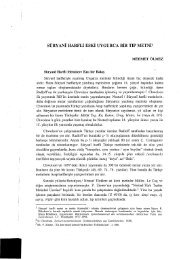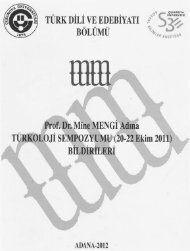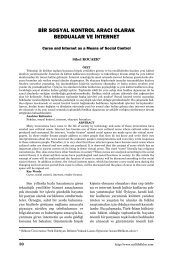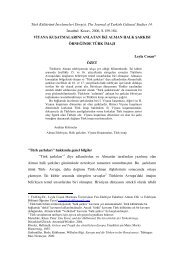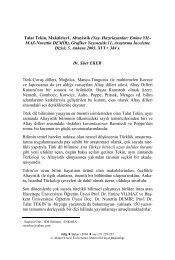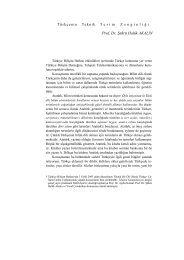Karagöz Co-Opted: Turkish Shadow Theatre of the Early Republic
Karagöz Co-Opted: Turkish Shadow Theatre of the Early Republic
Karagöz Co-Opted: Turkish Shadow Theatre of the Early Republic
Create successful ePaper yourself
Turn your PDF publications into a flip-book with our unique Google optimized e-Paper software.
3ATJ_292-341 6/1/06 11:46 AM Page 292<br />
<strong>Karagöz</strong> <strong>Co</strong>-<strong>Opted</strong>: <strong>Turkish</strong> <strong>Shadow</strong><br />
<strong>Theatre</strong> <strong>of</strong> <strong>the</strong> <strong>Early</strong> <strong>Republic</strong><br />
(1923–1945)<br />
Serdar Öztürk<br />
During <strong>the</strong> early <strong>Turkish</strong> republic karagöz shadow <strong>the</strong>atre’s Ottoman patterns were<br />
transformed. Reformers attempted to restrict c<strong>of</strong>feehouses where <strong>the</strong> art had flourished<br />
and developed written texts to replace <strong>the</strong> improvised practice <strong>of</strong> <strong>the</strong> past. They sponsored<br />
performances in government-supported community centers and created shows to promote<br />
government policies. The efforts meant that an art, which had grown from lower-class<br />
satire <strong>of</strong> <strong>the</strong> elite was purged <strong>of</strong> obscene elements, characters were changed to conform to<br />
modern ideology, and government control was asserted on what had been a domain <strong>of</strong><br />
free speech. It is possible that <strong>the</strong> efforts to restructure <strong>the</strong> once vibrant art helped hasten<br />
its decline.<br />
Serdar Öztürk is an assistant pr<strong>of</strong>essor at Gazi University, Faculty <strong>of</strong> <strong>Co</strong>mmunication.<br />
In 2005, he published a book (During <strong>the</strong> <strong>Early</strong> <strong>Republic</strong> Era: Cinema,<br />
Reception, and Politics [Erken Cumhuriyet Döneminde Sinema Seyir Siyaset]).<br />
His dissertation on c<strong>of</strong>feehouses in <strong>the</strong> <strong>Turkish</strong> <strong>Republic</strong> (1930–1945) was published<br />
in 2006 (The <strong>Co</strong>ffeehouse and Power in <strong>the</strong> <strong>Republic</strong> Turkey [Cumhuriyet<br />
Türkiyesi’nde Kahvehane ve I . ktidar]). He has published extensively in o<strong>the</strong>r<br />
formats about social and cultural topics.<br />
Ottoman Empire karagöz, <strong>the</strong> shadow <strong>the</strong>atre <strong>of</strong> <strong>the</strong> c<strong>of</strong>feehouses,<br />
was characterized by sexual and political humor, characteristics<br />
that it shares with genres like tolubommalata <strong>of</strong> India, <strong>the</strong> wayang <strong>of</strong><br />
Indonesia, and o<strong>the</strong>r puppet traditions <strong>of</strong> Asia and Eurasia. 1 This mixture<br />
<strong>of</strong> sexual liberty and lampooning those in power is characteristic<br />
<strong>of</strong> rural and lower-class entertainments. One <strong>of</strong> <strong>the</strong> conundrums that<br />
shadow <strong>the</strong>atre from Indonesia to Turkey has faced is, what happens<br />
to such forms with modernization? In Turkey, as with India (Tilakasari<br />
[1968]: 25–28) and Indonesia (Foley 1979: 248–261; Weintraub 2004),<br />
Asian <strong>Theatre</strong> Journal, vol. 23, no. 2 (Fall 2006). © 2006 by University <strong>of</strong> Hawai‘i Press. All rights reserved.
3ATJ_292-341 6/1/06 11:46 AM Page 293<br />
K ARAGÖZ CO-OPTED 293<br />
<strong>the</strong> government has intervened in traditional puppetry, enlisting <strong>the</strong><br />
art to support modernization. Language reform, public health, and<br />
governmental economic and social policies may be promoted. While<br />
Indian and Indonesian puppet <strong>the</strong>atres are still in <strong>the</strong> midst <strong>of</strong> <strong>the</strong>ir<br />
transformations, which began only after national independence in <strong>the</strong><br />
mid twentieth century, <strong>the</strong> karagöz went through a cycle <strong>of</strong> reformation<br />
prior to World War II and, since <strong>the</strong>n, a process <strong>of</strong> folklorization.<br />
This paper intends to look at <strong>the</strong> reformist phase and will note that <strong>the</strong><br />
process <strong>of</strong> revision probably contributed to <strong>the</strong> demise <strong>of</strong> <strong>the</strong> genre as<br />
a living art. While government <strong>of</strong>ficials were successful in implementing<br />
changes, those changes alienate <strong>the</strong> genre from its roots. While <strong>the</strong><br />
<strong>Turkish</strong> experience cannot predict <strong>the</strong> outcome <strong>of</strong> <strong>the</strong>se o<strong>the</strong>r puppet<br />
<strong>the</strong>atres, I hope that this effort can fill in a little-known era in <strong>the</strong> history<br />
<strong>of</strong> <strong>Turkish</strong> shadow <strong>the</strong>atre, and I believe <strong>the</strong> episode may provide<br />
an instructive model <strong>of</strong> what not to do if such arts are to be preserved.<br />
During <strong>the</strong> <strong>Turkish</strong> <strong>Republic</strong>, founded in 1923 and led until<br />
1945 under <strong>the</strong> single party rule <strong>of</strong> <strong>the</strong> <strong>Republic</strong>an People’s Party,<br />
<strong>the</strong>re was a struggle over <strong>the</strong> <strong>Turkish</strong> shadow <strong>the</strong>ater. The ruling elite<br />
and <strong>the</strong> common people contested what messages <strong>the</strong> <strong>the</strong>atre would<br />
Figure 1. The karagöz puppeteers Tuncay Tanbog˘a (Hayali Torun Çelebi)<br />
and Orhan Kurt in a view from behind <strong>the</strong> screen. (Photo: <strong>Co</strong>urtesy <strong>of</strong> The<br />
Traditional <strong>Turkish</strong> <strong>Theatre</strong> 1999: 21)
3ATJ_292-341 6/1/06 11:46 AM Page 294<br />
294 Öztürk<br />
carry, where it would be staged, and whose voice it would represent.<br />
This disagreement resulted in a transformational process. The art<br />
began at <strong>the</strong> Ottoman c<strong>of</strong>feehouses as a ribald <strong>the</strong>atre full <strong>of</strong> political<br />
satire; it moved to government cultural centers where <strong>the</strong> sexual content<br />
<strong>of</strong> <strong>the</strong> performance was excised and <strong>the</strong> political messages were<br />
aligned with government ideology. Finally, this gentrified <strong>the</strong>atre was<br />
returned to <strong>the</strong> c<strong>of</strong>feehouse <strong>of</strong> <strong>the</strong> early <strong>Republic</strong>. My chronological<br />
account <strong>of</strong> this transformation will highlight how karagöz changed in<br />
both location and content, pointing out how radical <strong>the</strong> displacement<br />
was and <strong>the</strong> degree to which it distanced <strong>the</strong> art from its primary function<br />
in Ottoman society.<br />
The First Period: <strong>Karagöz</strong> and <strong>the</strong><br />
Culture <strong>of</strong> <strong>Co</strong>ffeehouses<br />
Theatrical performances such as <strong>the</strong> <strong>Turkish</strong> shadow <strong>the</strong>ater<br />
(Tietze 1977: 19) spread with <strong>the</strong> increase <strong>of</strong> c<strong>of</strong>feehouses in <strong>the</strong> Ottoman<br />
Empire dating from about <strong>the</strong> seventeenth century and continuing<br />
on into <strong>the</strong> nineteenth century. Especially during Ramadan, <strong>the</strong><br />
fasting month, <strong>the</strong>atrical performances by <strong>the</strong> nineteenth century<br />
attracted audiences interested in <strong>the</strong> political satire and sexual humor<br />
in karagöz. Throughout this most holy month in Islam, no food or<br />
drink was consumed during <strong>the</strong> day, so feasts and entertainments were<br />
held after sundown. People flocked to c<strong>of</strong>feehouses for food for <strong>the</strong><br />
body and <strong>the</strong> mind through enjoyment <strong>of</strong> a karagöz show (22).<br />
The political stance <strong>of</strong> <strong>the</strong> karagöz had always been that <strong>of</strong> <strong>the</strong><br />
little guy criticizing <strong>the</strong> powerful. Puppeteers and audiences in <strong>the</strong> c<strong>of</strong>feehouses<br />
were largely common people, and <strong>the</strong> <strong>the</strong>atre presented a<br />
bottom-up critique <strong>of</strong> <strong>the</strong> powerful <strong>of</strong> Ottoman society and <strong>the</strong> social<br />
constraints that framed <strong>the</strong>ir normal life. Even <strong>the</strong> myth about <strong>the</strong> <strong>the</strong>atre’s<br />
origin tells <strong>of</strong> a man who wanted to make <strong>the</strong> sultan see his <strong>of</strong>ficials’<br />
corruption. He created shadow figures and performed a karagöz<br />
presenting such behavior before <strong>the</strong> sultan. The sultan, impressed by<br />
<strong>the</strong> play, punished his corrupt <strong>of</strong>ficials and appointed this puppeteer<br />
as his grand vizier. Many people followed <strong>the</strong> example <strong>of</strong> this ur-puppeteer,<br />
infusing karagöz shows with critique (And 1963–1964: 39). The<br />
performances <strong>of</strong> karagöz at nineteenth-century Ottoman c<strong>of</strong>feehouses<br />
were full <strong>of</strong> political satire, and high <strong>of</strong>ficials and grand viziers were<br />
fair game.<br />
<strong>Karagöz</strong> was commonly employed as a political weapon to criticize<br />
political corruption (Hattox 1996: 106). European visitors regularly<br />
noted <strong>the</strong> extreme freedom which puppet masters exercised.<br />
Méry (1855) noted, “<strong>Karagöz</strong> defies <strong>the</strong> censorship, enjoying an unlimited<br />
freedom.” In comparison, Méry found that France, America, and
3ATJ_292-341 6/1/06 11:46 AM Page 295<br />
K ARAGÖZ CO-OPTED 295<br />
England were much more restricted in political criticism. For him,<br />
“<strong>Karagöz</strong> was a daily newspaper, without security, without stamp, without<br />
a responsible editor, a terrible newspaper because it can not write,<br />
it talks and sings in front <strong>of</strong> its numerous subscribers.” Méry claimed<br />
that “if in ano<strong>the</strong>r country a newspaper were to write even a single line<br />
<strong>of</strong> <strong>the</strong> numerous plays <strong>of</strong> karagöz,” it would be sufficient to bring about<br />
<strong>the</strong> arrest and exile <strong>of</strong> <strong>the</strong> journalist (cited by Kömeçog˘lu 2001: 94).<br />
In <strong>the</strong> words <strong>of</strong> ano<strong>the</strong>r nineteenth-century observer, Louis<br />
Enault:<br />
In Turkey, a country governed by an absolute monarchy and a totalitarian<br />
regime, <strong>Karagöz</strong> is a character who never deceives himself or is<br />
soo<strong>the</strong>d into a sense <strong>of</strong> security by shutting his eyes to <strong>the</strong> ills surrounding<br />
him. On <strong>the</strong> contrary, a karagöz show is a risqué-revue, as<br />
Figure 2. Hacivat and <strong>Karagöz</strong> are <strong>the</strong> major characters in <strong>the</strong> traditional<br />
shadow <strong>the</strong>atre. <strong>Karagöz</strong> represents <strong>the</strong> voice <strong>of</strong> <strong>the</strong> common man, while<br />
Hacivat, who represents higher class ideas, is <strong>of</strong>ten mocked. (Photo: <strong>Co</strong>urtesy<br />
<strong>of</strong> The Traditional <strong>Turkish</strong> <strong>Theatre</strong> 1999: 25)
3ATJ_292-341 6/1/06 11:46 AM Page 296<br />
296 Öztürk<br />
brave as a militant newspaper. No one is spared, except maybe <strong>the</strong><br />
Sultan. <strong>Karagöz</strong> passes judgment on <strong>the</strong> Grand Vizier and sentences<br />
him to <strong>the</strong> prisons <strong>of</strong> Yedikule. His gibes prove disturbing to foreign<br />
ambassadors; he hits out at <strong>the</strong> Allied Admirals <strong>of</strong> <strong>the</strong> Black Sea fleet,<br />
and <strong>the</strong> generals <strong>of</strong> <strong>the</strong> Crimean armies at <strong>the</strong> time <strong>of</strong> <strong>the</strong> <strong>Turkish</strong>-<br />
Russian war <strong>of</strong> 1854–6. (Cited by Kömeçog˘lu 2001: 94–95)<br />
In <strong>the</strong> same period, traveler Gérard de Nerval wrote about <strong>the</strong><br />
political content and effect on Istanbul c<strong>of</strong>feehouse clientele. Nerval<br />
clarified that karagöz always represented <strong>the</strong> opposition. <strong>Karagöz</strong>, he<br />
believed, was always <strong>the</strong> representative <strong>of</strong> <strong>the</strong> folk who mocked <strong>the</strong><br />
nobles or criticized <strong>the</strong> ruler’s mistakes (cited by Kömeçog˘lu 2001:<br />
57). For example, <strong>the</strong> French traveler Wanda reported that Hüsrev<br />
Pas¸a, <strong>the</strong> grand vizier <strong>of</strong> Mahmut II, was mocked by <strong>Karagöz</strong> for his<br />
homosexual preferences (Mehmet Süreyya 1996: 682–683). Wanda<br />
witnessed <strong>the</strong> criticisms against high <strong>of</strong>ficials and even <strong>the</strong> sultan in<br />
karagöz plays. For example, in one c<strong>of</strong>feehouse shadow play a young<br />
man wants some advice from <strong>Karagöz</strong> on which pr<strong>of</strong>ession he should<br />
choose. <strong>Karagöz</strong> replies, “Since you do not know anything, I advise you<br />
to become a chief admiral.” The young man becomes an admiral and<br />
attacks rats. The sultan rewards this admiral after his victory, marrying<br />
him to his daughter (And 1963–1964: 39; see also And 1985: 294). 2<br />
Within <strong>the</strong> hierarchically stratified society <strong>of</strong> <strong>the</strong> nineteenth<br />
century, <strong>Karagöz</strong> exercised extraordinary license. <strong>Karagöz</strong>’s sexually<br />
loaded puns <strong>the</strong>mselves are revolutionary. “Even when <strong>the</strong>re is no political<br />
<strong>the</strong>me or figure, <strong>the</strong> performance has a subversive political character<br />
which expresses itself symbolically in <strong>the</strong> deliberate violation <strong>of</strong><br />
<strong>of</strong>ficially held cultural norms, values, and linguistic codes” (Kırlı 2000:<br />
164). One finds evidence <strong>of</strong> karagöz’s licentiousness not only in <strong>the</strong><br />
report <strong>of</strong> Western travelers’ observations at c<strong>of</strong>feehouses but also in<br />
<strong>the</strong> texts written by Nazif Bey, a court puppeteer. <strong>Karagöz</strong>, <strong>the</strong> main<br />
character <strong>of</strong> Nazif Bey’s play, utters words with sexual connotations.<br />
For example, “kaldırmak,” which literally means “to lift,” connotes <strong>the</strong><br />
erection <strong>of</strong> <strong>the</strong> penis; “yapmak,” which means “to perform,” connotes<br />
sexual performance; “aybas¸ı,” which means <strong>the</strong> first day <strong>of</strong> <strong>the</strong> month<br />
when salaries are paid, has a connotation <strong>of</strong> menstruation (Mizrahi<br />
1991: 136). <strong>Karagöz</strong>’s sexual liberation clearly cut across classes, but<br />
textual analysis does little justice to <strong>the</strong> phallocentric imagery on <strong>the</strong><br />
screen.<br />
The image <strong>of</strong> <strong>Karagöz</strong>’s penis was <strong>of</strong>ten featured. A photograph<br />
shows <strong>Karagöz</strong> with a phallus (Martinovitch 1933: 2). In <strong>the</strong> words <strong>of</strong><br />
Mizrahi, “There were special words in <strong>the</strong> puppeteers’ jargon for a performance<br />
that contained a phallus: zekerli or toramanlı <strong>Karagöz</strong>” (1991:
3ATJ_292-341 6/1/06 11:46 AM Page 297<br />
K ARAGÖZ CO-OPTED 297<br />
22). Even court puppeteer Nazif Bey stated that sometimes you could<br />
see women check on <strong>Karagöz</strong>’s male organ in <strong>the</strong> play (22).<br />
Western travelers reconfirm <strong>the</strong> fact that sexuality was abundant<br />
in nineteenth-century performance. Charles White stated that <strong>the</strong> dialogues<br />
in karagöz “were beyond all enduring obscene” (1845: 121).<br />
Gérard de Nerval was shocked when he saw children playing with<br />
karagöz images, given <strong>the</strong>ir association with sex: “It is incredible that<br />
this indecent figure be put without scruple at <strong>the</strong> hand <strong>of</strong> <strong>the</strong> youth.<br />
This is, however, <strong>the</strong> most frequent present that a fa<strong>the</strong>r or a mo<strong>the</strong>r<br />
gives to <strong>the</strong>ir children” (cited by Kömeçog˘lu 2001: 96). G. A. Olivier<br />
stated, “We had every evening, in a c<strong>of</strong>fee-house open to all <strong>the</strong> curious<br />
and all <strong>the</strong> amateurs, a sight much relished by <strong>the</strong> Turks, and frequented<br />
even by <strong>the</strong> most decent women, although it most frequently<br />
presented scenes at which European families, <strong>the</strong> most shameless,<br />
would have blushed to be present” (1801: 137).<br />
As Boratav (1942: 30) as well as And (1964: 15–18) note, some<br />
have claimed such reports must be spurious since <strong>the</strong>y believe karagöz<br />
was a mystical play. Yet research clarifies that this mysticism is confined<br />
to <strong>the</strong> “Curtain Poems” 3 at <strong>the</strong> beginning <strong>of</strong> plays, and most nineteenth-century<br />
reports highlight <strong>the</strong> obscenity and satire that pervade<br />
<strong>the</strong> whole <strong>of</strong> <strong>the</strong> performance. Even if <strong>the</strong> show may have had older<br />
linkages to ei<strong>the</strong>r agrarian fertility patterns as we see in <strong>the</strong> puppetry<br />
<strong>of</strong> India (UCLA Museum <strong>of</strong> Cultural History 1976: 16) or Sufi or<br />
tantric patterns as we find in forms like Indonesian wayang, by <strong>the</strong><br />
nineteenth century <strong>the</strong>se ties were no longer clear to <strong>Turkish</strong> puppeteers.<br />
By <strong>the</strong>n <strong>the</strong> function <strong>of</strong> <strong>the</strong> Curtain Poems was merely to disguise<br />
<strong>the</strong> political and sexual character <strong>of</strong> <strong>the</strong> play and to buy immunity.<br />
<strong>Karagöz</strong> is not simple pornography but ra<strong>the</strong>r “symbolic inversion<br />
<strong>of</strong> commonly held norms and behaviors through <strong>the</strong> medium <strong>of</strong><br />
sexuality” (Kırlı 2000: 170). As Kırlı points out, karagöz<br />
Involves <strong>the</strong> elements <strong>of</strong> degradation and debasement <strong>of</strong> <strong>the</strong> higher,<br />
precisely because it takes place in <strong>the</strong> context <strong>of</strong> a dialogue with Hacivat,<br />
who was depicted to represent <strong>the</strong> higher culture <strong>of</strong> elites in every<br />
conceivable way ranging from <strong>the</strong> way he speaks, which is unintelligible<br />
to <strong>Karagöz</strong>, to his cultured manners, from his selfishness to his<br />
constant attempt to domesticate <strong>Karagöz</strong>. To <strong>the</strong> extent that <strong>Karagöz</strong><br />
beats and trashes Hacivat, <strong>the</strong> former brings down <strong>the</strong> privileged symbols<br />
and <strong>of</strong>ficially authorized norms associated with <strong>the</strong> latter. To <strong>the</strong><br />
extent that Hacivat represents [<strong>the</strong>] upper body with refined manners<br />
and symbols <strong>of</strong> high culture, <strong>Karagöz</strong> emphasizes <strong>the</strong> lower body with<br />
eating, cursing, defecation, and [<strong>the</strong>] phallus. To <strong>the</strong> extent that Haci-
3ATJ_292-341 6/1/06 11:46 AM Page 298<br />
298 Öztürk<br />
vat epitomizes culture, <strong>Karagöz</strong> symbolizes nature where everybody is<br />
alike and nobody can claim a higher status. (170)<br />
Thanks to <strong>the</strong> detailed descriptions <strong>of</strong> European travelers we<br />
know that in <strong>the</strong> nineteenth century karagöz was a people’s <strong>the</strong>atre,<br />
which attacked <strong>the</strong> corruption <strong>of</strong> <strong>the</strong> rulers and provided a respite<br />
from <strong>the</strong> sexual repression that normal society espoused. It was a freefor-all<br />
art form where <strong>the</strong> spirit <strong>of</strong> carnival abjured <strong>the</strong> everyday. Political<br />
satire was an essential element in <strong>the</strong> shadow <strong>the</strong>ater, but this<br />
changed in <strong>the</strong> reigns <strong>of</strong> Sultan Abdülaziz (1861–1876) and especially<br />
Abdulhamid II (1876–1909), when censure suppressed open political<br />
discourse (And 1963–1964: 38; Kırlı 2000: 165).<br />
The Second Period: <strong>Co</strong>ntrolling <strong>Co</strong>ntent<br />
Starting from <strong>the</strong> late nineteenth century, political and sexual<br />
restrictions were imposed on what had previously been an uncensored<br />
<strong>the</strong>atre. Puppeteers would be forced to speak more metaphorically<br />
about issues that had traditionally been out in <strong>the</strong> open. At <strong>the</strong> same<br />
time court puppeteers began reforms and created fixed scripts. This<br />
tendency toward defined texts served <strong>the</strong> impulse to control what had<br />
previously been an improvised form. All <strong>the</strong>se efforts exemplify <strong>the</strong><br />
top-down control being imposed on what had previously been a bottom-up<br />
<strong>the</strong>atre <strong>of</strong> satire and license.<br />
An important pasha, Kıbrıslı Mehmet Pas¸a, a dignitary <strong>of</strong> Sultan<br />
Abdulaziz (1861–1876), along with his family was depicted embezzling<br />
money from <strong>the</strong> state (Mehmet Sureyya 1996: 1037–1038; Kömeçog˘lu<br />
2001: 96). In this play, while <strong>the</strong> pasha is “moving his hands like<br />
a windmill” and saying at <strong>the</strong> top <strong>of</strong> his voice he knows <strong>the</strong> thieves and<br />
how <strong>the</strong>y have filled <strong>the</strong>ir pockets, we see his wife, his bro<strong>the</strong>r-in-law,<br />
and son-in-law in front <strong>of</strong> him, <strong>the</strong>ir pockets stuffed with loot. From this<br />
date, <strong>the</strong> government made clear that if performers criticized state bigwigs<br />
in performance, <strong>the</strong>y would be punished severely (Kudret 1968:<br />
38). As a result, direct political criticism <strong>of</strong> state <strong>of</strong>ficials was no longer<br />
to be found. Obscenity also lost its prominence because <strong>of</strong> <strong>the</strong> restrictions<br />
imposed on <strong>the</strong> karagöz performances. Such bans turned karagöz<br />
into “childish vacuity and meaningless farce” (And 1979: 85–86). This<br />
suppression <strong>of</strong> sexual content was characteristic <strong>of</strong> <strong>the</strong> modernization<br />
process <strong>of</strong> <strong>the</strong> Ottoman Empire. Since <strong>the</strong> start <strong>of</strong> Tanzimat (“turning<br />
point”) in 1839, Western moral values were increasingly important in<br />
<strong>the</strong> empire.<br />
But <strong>the</strong> greatest shift was yet to come. In 1918, Nazif Bey, <strong>the</strong> last<br />
Ottoman court puppeteer, collected unwritten karagöz plays to remove<br />
undesirable political comment and crude expressions. While seem-
3ATJ_292-341 6/1/06 11:46 AM Page 299<br />
K ARAGÖZ CO-OPTED 299<br />
ingly innocuous, this step may have had more impact than all <strong>the</strong> bans<br />
and restrictions. These expurgated written plays were not <strong>the</strong> same as<br />
<strong>the</strong> improvised versions. The fixed texts with <strong>the</strong> imprimatur <strong>of</strong> <strong>the</strong><br />
elite were, <strong>of</strong> course, held up as models for o<strong>the</strong>r puppeteers.<br />
Even though overt political <strong>the</strong>mes in karagöz were banned, <strong>the</strong><br />
<strong>the</strong>atre continued to convey its political messages through innuendo<br />
at c<strong>of</strong>feehouses. To an extent, despite intensive police controls, karagöz<br />
maintained its obscene characteristic (And 1969: 135–137; Boratav<br />
1942: 30). Still, Kömeçog˘lu remarks, “Although karagöz could not<br />
regain <strong>the</strong> pungent trait <strong>of</strong> its character, its political essence was carried<br />
on to <strong>the</strong> newspapers, many <strong>of</strong> which had titles borrowed from<br />
karagöz” (2001: 96). Government and propriety was on <strong>the</strong> ascendant.<br />
While <strong>Karagöz</strong> survived as a cultural archetype, his <strong>the</strong>atrical emasculation<br />
had begun.<br />
The Third Period: Top-Down Politicization<br />
As indicated before, during <strong>the</strong> reign <strong>of</strong> Sultan Abdülaziz overt<br />
political comment was banned by <strong>the</strong> Ottoman Empire and <strong>the</strong> sexual<br />
comment <strong>of</strong> <strong>the</strong> <strong>the</strong>atre was curtailed; this was implemented by<br />
attempts to “set” plays via bowderized texts as in <strong>the</strong> version <strong>of</strong> Nazif<br />
Bey. In <strong>the</strong> early <strong>Republic</strong> <strong>of</strong> Turkey (1923–1945), <strong>the</strong> <strong>Turkish</strong> shadow<br />
<strong>the</strong>atre’s top-down political pressure continued, and <strong>the</strong> form was fundamentally<br />
coopted by its one time adversary, <strong>the</strong> elite class, with its<br />
narrow moral values. After <strong>the</strong> Independence War (1919–1922) <strong>the</strong><br />
<strong>Republic</strong> <strong>of</strong> Turkey was founded in 1923. Mustafa Kemal Atatürk, <strong>the</strong><br />
founder <strong>of</strong> <strong>the</strong> new state, attempted to modernize Turkey through<br />
one-party rule <strong>of</strong> his <strong>Republic</strong>an People’s Party, which prevailed until<br />
1945.<br />
In this period <strong>the</strong> hegemony <strong>of</strong> <strong>the</strong> Tanzimat modernization<br />
movement moved toward completion. As clo<strong>the</strong>s, laws, rights, and daily<br />
life transformed, this art seemed increasingly old-fashioned. Emasculated<br />
by bans, karagöz languished. The genre was both part <strong>of</strong> what <strong>the</strong><br />
modern person wanted to leave behind and, at <strong>the</strong> same time, only a<br />
ghost <strong>of</strong> <strong>the</strong> lusty form <strong>of</strong> <strong>the</strong> past. A new shadow show, <strong>the</strong> cinema,<br />
was <strong>the</strong> art <strong>of</strong> <strong>the</strong> times. Therefore, <strong>the</strong> puppeteers attempted changes<br />
in karagöz, first through technical innovations such as <strong>the</strong> introduction<br />
<strong>of</strong> electric lighting and large screens, <strong>the</strong>n by changing <strong>the</strong> content.<br />
The fez was replaced with a bowler, a traditional dance became <strong>the</strong><br />
Charleston, and soon that arch-anarchist <strong>Karagöz</strong> was drafted into <strong>the</strong><br />
nationalist enterprise. Like <strong>the</strong> English Punch and <strong>the</strong> German Kasper,<br />
<strong>Karagöz</strong> was a clown caught between past and future. The government<br />
hoped for him to set <strong>the</strong> pace for popular reform, but he changed too<br />
slowly for this. Meanwhile, he changed too quickly for his traditional
3ATJ_292-341 6/1/06 11:46 AM Page 300<br />
300 Öztürk<br />
audience, who found he no longer represented <strong>the</strong>m. Puppeteers,<br />
reformists, and newspapermen puzzled about his future.<br />
The two famous puppeteers, Sefa and I . rfan, were among those<br />
saying, “<strong>Karagöz</strong> must be modernized,” and Sefa asserted that <strong>Karagöz</strong><br />
had to be “<strong>the</strong> newest American comic,” “Mick[e]y” (Feridun 1931: 3).<br />
Hikmet Feridun, an elite journalist who while not part <strong>of</strong> <strong>the</strong> government<br />
shared its ideology, claimed that karagöz would surpass Mickey<br />
Mouse if <strong>the</strong> <strong>the</strong>atre could reflect <strong>the</strong> innovations <strong>of</strong> <strong>the</strong> age. “Think<br />
for a while how animated pictures, called Mickey, have <strong>the</strong> world<br />
eating out <strong>of</strong> <strong>the</strong>ir hands. But Mickey’s many followers are children,<br />
whereas <strong>Karagöz</strong>’s witty remarks give adults fun as well as children.<br />
[Mickey Mouse] Films are like snacks, ordinary and easy to get, whereas<br />
karagöz is a treasure, which can never be found anywhere else for<br />
adults and children” (Feridun 1933: 2).<br />
On <strong>the</strong> pretext <strong>of</strong> karagöz’s modernization, attempts were<br />
made to transform it into a top-down enterprise. For instance, in 1933<br />
Mustafa Rahmi (Balaban) 4 founded Association <strong>of</strong> Friends <strong>of</strong> <strong>Karagöz</strong><br />
(<strong>Karagöz</strong> Dostları Derneg˘i) to modernize karagöz for <strong>the</strong> benefit<br />
<strong>of</strong> <strong>the</strong> new state. <strong>Karagöz</strong>, according to Association Chairman Rahmi,<br />
could “increase individual enterprise”: “For example, <strong>Karagöz</strong> is unemployed.<br />
He is occupied with washing laundry. Hacivat deals with find-<br />
Figure 3. As part <strong>of</strong> modernization, <strong>the</strong> fez <strong>of</strong> <strong>the</strong> Çelebi (Womanizer)<br />
and <strong>the</strong> veil <strong>of</strong> <strong>the</strong> Zenne (Female) were replaced with more modern dress.<br />
(Photo: <strong>Co</strong>urtesy <strong>of</strong> The Traditional <strong>Turkish</strong> <strong>Theatre</strong> 1999: 26)
3ATJ_292-341 6/1/06 11:46 AM Page 301<br />
K ARAGÖZ CO-OPTED 301<br />
ing a job for him. But he cannot encourage <strong>Karagöz</strong> to be a civil<br />
servant, to receive a salary, to find a job in <strong>the</strong> government service!<br />
He advises <strong>Karagöz</strong> to open a shop and trade. This means he may<br />
encourage him in dealing with individual enterprise” (Feridun 1933:<br />
2). <strong>Karagöz</strong> was in such attempts a propaganda tool for <strong>Turkish</strong> modernization,<br />
which promoted reforms in language, clothing, and<br />
education.<br />
“<strong>Karagöz</strong> and Hacivat (<strong>the</strong> core figures who are foils for one<br />
ano<strong>the</strong>r) were likely to conform to every ‘reform’ and ‘welcome <strong>the</strong><br />
revolution’” (Feridun 1931: 3). Yet this was a top-down process, which<br />
stood in stark contrast to how karagöz <strong>the</strong>atre traditionally had evolved.<br />
Adaptations to each age were realized by <strong>the</strong> negotiations between <strong>the</strong><br />
c<strong>of</strong>feehouse clientele and <strong>the</strong> puppeteers, not by a dictum from<br />
above. Clientele <strong>of</strong> c<strong>of</strong>feehouses and <strong>the</strong> puppeteers, not rulers in <strong>the</strong><br />
court, traditionally brought innovation to karagöz.<br />
For instance, <strong>the</strong> drunkard Tuzsuz Deli Bekir, a character in<br />
karagöz, represented <strong>the</strong> tough Janissaries. The Janissaries formed<br />
basic military force <strong>of</strong> <strong>the</strong> Ottoman Empire prior to annihilation <strong>of</strong><br />
<strong>the</strong>se units by <strong>the</strong> Sultan Mahmut II in 1826 when <strong>the</strong>y sparked rebellions<br />
from <strong>the</strong>ir own c<strong>of</strong>feehouses. In karagöz plays this rowdy character<br />
has a dagger in one hand and a wine pot in <strong>the</strong> o<strong>the</strong>r. He lets out<br />
a yell and is proud <strong>of</strong> killing his mo<strong>the</strong>r, fa<strong>the</strong>r, and 999 o<strong>the</strong>rs. This<br />
character was removed from <strong>the</strong> plays when <strong>the</strong> Janissary force was<br />
eliminated (Siyavus¸gil 1941: 167–168). Soon a new and larger figure<br />
named Swashbuckler (Efe) took his place. During <strong>the</strong> time <strong>of</strong> Sultan<br />
Abdülhamit II (1876–1908), Rowdy (Külhanbeyi) replaced Swashbuckler,<br />
since he better reflected that period (Kudret 1968: 31). These innovations<br />
were part <strong>of</strong> <strong>the</strong> natural evolution <strong>of</strong> <strong>the</strong> art to reflect a changing<br />
society. These alterations were not dictated by those outside <strong>the</strong><br />
natural circle <strong>of</strong> performer and audience.<br />
The State Intervention in <strong>Karagöz</strong> at <strong>Co</strong>ffeehouses<br />
In Anatolian cities, districts, boroughs, and villages during <strong>the</strong><br />
early years <strong>of</strong> <strong>the</strong> <strong>Republic</strong>, ordinary c<strong>of</strong>feehouse audiences still watched<br />
modern karagöz plays, which employed both technical innovations (cinema-sized<br />
screens and electric light) and content changes (reflecting<br />
<strong>the</strong> reforms in <strong>the</strong> framework <strong>of</strong> <strong>the</strong> Western modernization) 5 . Even<br />
in Istanbul, where <strong>the</strong> cinema, radio, and modern <strong>the</strong>atre that began<br />
to emerge during <strong>the</strong> early <strong>Republic</strong> years competed, people were still<br />
addicted to watching c<strong>of</strong>feehouse karagöz plays. Some evidence <strong>of</strong> sexual<br />
and political critique exists. For example, in 1932, a c<strong>of</strong>feehouse<br />
puppet show depicted <strong>the</strong> effects <strong>of</strong> <strong>the</strong> World Economic Depression<br />
on <strong>Turkish</strong> society:
3ATJ_292-341 6/1/06 11:46 AM Page 302<br />
302 Öztürk<br />
The play <strong>of</strong> this puppet company is really strong. On <strong>the</strong> screen are a<br />
wife and a husband. Both <strong>of</strong> <strong>the</strong>m complain about hunger. The wife<br />
at some time <strong>of</strong>fers:<br />
My dear husband, this can’t go on like this. Why don’t we eat each<br />
o<strong>the</strong>r?<br />
The man agrees:<br />
Alright! Let me eat you first. Then you can eat me. (“Kuklaya Gel<br />
Kuklaya!” 1932: 2)<br />
In response came a Ministry <strong>of</strong> Internal Affairs decree ordering<br />
<strong>the</strong> police to severely monitor such improvised productions (“Tiyatro<br />
Temsilleri” 1932). Toward <strong>the</strong> end <strong>of</strong> <strong>the</strong> same year, <strong>the</strong> ministry issued<br />
a second decree, which emphasized <strong>the</strong> improvised productions had<br />
“obscene” and “harmful” elements, so every police station had to control<br />
<strong>the</strong> c<strong>of</strong>feehouses in its own district. In addition, <strong>the</strong> puppeteers<br />
who performed <strong>the</strong>se kinds <strong>of</strong> plays were to be prosecuted (“Geceleri<br />
<strong>Karagöz</strong>” 1932).<br />
In 1933 came yet ano<strong>the</strong>r decree curtailing hours for cinemas,<br />
<strong>the</strong>atres, and <strong>the</strong> c<strong>of</strong>feehouses at which karagöz and folk storytellers<br />
performed. All <strong>the</strong>se entertainment places were to close at 23:00<br />
instead <strong>of</strong> 24:00 (APM, Catalog 030.10/88.581.13) to protect <strong>the</strong> physical<br />
and mental health <strong>of</strong> people. In all developed countries, according<br />
to <strong>the</strong> decree, such places closed around this time, so if Turkey was to<br />
compete with developed countries, <strong>the</strong> populace needed <strong>the</strong>ir sleep to<br />
work harder. However, <strong>the</strong> newspaper Hakimiyet-i Milliye, which was <strong>the</strong><br />
<strong>of</strong>ficial voice <strong>of</strong> <strong>the</strong> government, singled out <strong>the</strong> root problem: c<strong>of</strong>feehouses<br />
could not represent <strong>the</strong> new state, and <strong>the</strong>y had to be modernized<br />
completely (“Kahvelerin Gece Onbirden Sonra Açık Tutulması<br />
Yasak” 1933). Though we lack descriptions <strong>of</strong> <strong>the</strong> actual performances<br />
that prompted <strong>the</strong> decrees, <strong>the</strong>se restrictions prove that karagöz was still<br />
popular at c<strong>of</strong>feehouses, <strong>the</strong> number <strong>of</strong> people going to c<strong>of</strong>feehouses<br />
was high, and <strong>the</strong> content was certainly obscene and probably political.<br />
A New Place for Modern <strong>Karagöz</strong>: People’s Houses<br />
<strong>Co</strong>nsidering <strong>the</strong> power <strong>of</strong> karagöz journalist Ercüment Ekrem<br />
Talu (1938) said, “<strong>Karagöz</strong> is one <strong>of</strong> <strong>the</strong> best means <strong>of</strong> propaganda” for<br />
<strong>the</strong> government, if “it can get this play under control” (3). He continued,<br />
“<strong>Karagöz</strong> can inspire everything because <strong>of</strong> people’s interest in<br />
him. People not only love him, but also believe and accept every word<br />
coming out <strong>of</strong> his mouth” (5). Journalist Dervis¸ Edesan (1942) agreed:<br />
<strong>the</strong> form was ripe for “suggestions” and “ideas” and had potential for<br />
<strong>the</strong> scientific and technical education <strong>of</strong> <strong>the</strong> people (5).
3ATJ_292-341 6/1/06 11:46 AM Page 303<br />
K ARAGÖZ CO-OPTED 303<br />
After 1932, <strong>the</strong> government took <strong>the</strong> initiative in bringing <strong>the</strong><br />
<strong>the</strong>atre under fuller control by changing <strong>the</strong> location, purifying it <strong>of</strong><br />
immoral, ill-mannered messages, and filling it with its own ideology.<br />
<strong>Karagöz</strong> was employed at People’s Houses, which <strong>the</strong> government set<br />
up in 1932 to spread its ideological principles. These were government-funded<br />
institutions that were to educate <strong>the</strong> populace, familiarizing<br />
<strong>the</strong>m with reforms and new ideology. <strong>Republic</strong>anism, nationalism,<br />
statism, populism, secularism, and revolutionism were <strong>the</strong><br />
principles <strong>of</strong> <strong>the</strong> <strong>Republic</strong> <strong>of</strong> Turkey.<br />
A karagöz screen was to be set up at every People’s House in<br />
order to deliver <strong>the</strong> political messages <strong>of</strong> <strong>the</strong> government (Talu 1938:<br />
3–5) and intellectuals claimed “<strong>Karagöz</strong> should become widespread by<br />
using every People’s House” (Edesan 1942: 5). But which plays could<br />
be performed <strong>the</strong>re? Of course, modernized plays were approved by<br />
<strong>the</strong> intellectuals. Thus, on 23 April 1932, National Sovereignty and<br />
Children’s Day, for <strong>the</strong> first time karagöz was taken into People’s Houses<br />
(“Çocuk Bayramı Kutlamaları” 1932). In 1935, when <strong>the</strong> arguments on<br />
<strong>the</strong> <strong>Turkish</strong> shadow <strong>the</strong>ater reached <strong>the</strong>ir peak, ano<strong>the</strong>r approved<br />
karagöz play was sponsored at Eminönü People’s House, Istanbul.<br />
Puppeteer Hazım, who performed c<strong>of</strong>feehouse karagöz in <strong>the</strong> 1920s,<br />
spoke at “<strong>Karagöz</strong> Night” on <strong>the</strong> topic “Why do we liven up karagöz?”<br />
and <strong>the</strong>n did his show (“<strong>Karagöz</strong>cü Hazım Anlatıyor” 1942). People’s<br />
House karagöz was a tool <strong>of</strong> government propaganda: “We must play<br />
karagöz in a corner <strong>of</strong> People’s House and insert our principles into it.<br />
Thus, we can easily spread our ideas. Besides, karagöz could attract<br />
people to People’s Houses when, for example, a conference is held. It<br />
is possible to add some variations to classical karagöz plays and turn<br />
<strong>the</strong>m into modern ones” (“<strong>Karagöz</strong> Oyunu” 1939: 9). So, in 1939, <strong>the</strong><br />
<strong>Republic</strong>an People’s Party ordered that all People’s Houses perform<br />
modernized karagöz plays in every village and town (“<strong>Karagöz</strong>cü Hazım<br />
Anlatıyor” 1942). From now on, <strong>the</strong>se new scenarios would be performed<br />
at People’s House. 6 <strong>Karagöz</strong>, <strong>the</strong> anarchist, was now a government<br />
propagandist. While c<strong>of</strong>feehouse performance, which had to be<br />
responsive to its audience, continued, this new phenomena <strong>of</strong> People’s<br />
House karagöz would have deep impact. Let me give an example<br />
<strong>of</strong> such new plays in order to explain how karagöz changed.<br />
A <strong>Karagöz</strong> Play at People’s House<br />
I . smail Hakkı Baltacıog˘lu, <strong>the</strong> owner and editor <strong>of</strong> Yeni Adam,<br />
wrote a modern karagöz, <strong>Karagöz</strong> in Ankara (<strong>Karagöz</strong> Ankara’da) in<br />
1940. Even <strong>the</strong> title informs us <strong>of</strong> <strong>the</strong> transformation. In 1923, Ankara<br />
was proclaimed <strong>the</strong> capital <strong>of</strong> <strong>the</strong> new state in place <strong>of</strong> Istanbul, <strong>the</strong> capital<br />
<strong>of</strong> <strong>the</strong> Ottoman Empire. Ankara represented <strong>Turkish</strong> modernity,
3ATJ_292-341 6/1/06 11:46 AM Page 304<br />
304 Öztürk<br />
and a new and modern karagöz would inhabit this new and modern<br />
capital. <strong>Co</strong>ffeehouses and Istanbul were part <strong>of</strong> an imperial past. People’s<br />
Houses and Ankara were <strong>the</strong> present and future <strong>of</strong> a modern<br />
nation-state. The object <strong>of</strong> <strong>the</strong> political satire, <strong>the</strong> characterizations,<br />
and <strong>the</strong> clientele were all in flux, as we see in this script.<br />
<strong>Karagöz</strong> in Ankara is political, but instead <strong>of</strong> criticizing state<br />
authorities, it reversed <strong>the</strong> direction and speaks in favor <strong>of</strong> <strong>the</strong> state.<br />
This meant a reversal <strong>of</strong> roles for <strong>Karagöz</strong>, who goes from being a<br />
lower-class anarchist to a new, model citizen. In <strong>the</strong> traditional shadow<br />
<strong>the</strong>atre <strong>of</strong> <strong>the</strong> Ottoman Empire, <strong>the</strong> realist Hacivat is educated, respectable,<br />
and cultured (if selfish and insincere), an Arabic speaker who<br />
always works to maintain <strong>the</strong> status quo. <strong>Karagöz</strong> is uneducated and<br />
flouts conventional morality; simple, albeit arrogant, he understands<br />
only bits <strong>of</strong> Arabic and is always eager for new ideas. As Smith states:<br />
In <strong>the</strong> karagöz plays, it is <strong>Karagöz</strong> himself who is <strong>the</strong> fool that is raised<br />
to power. That power is <strong>of</strong>ten seized at <strong>the</strong> very beginning <strong>of</strong> <strong>the</strong> play,<br />
where Hacivat, <strong>the</strong> morally upright and intelligent character, gives<br />
power to <strong>Karagöz</strong> and is immediately beaten. Once <strong>Karagöz</strong> has power,<br />
situations arise, ei<strong>the</strong>r from <strong>the</strong> acts <strong>of</strong> <strong>Karagöz</strong> himself or from o<strong>the</strong>r<br />
characters, which opens up <strong>the</strong> normal societal controls on sex and<br />
violence. At <strong>the</strong> end <strong>of</strong> most plays, <strong>Karagöz</strong> loses his power and society<br />
returns to normal: <strong>the</strong> dandy gets <strong>the</strong> courtesan, and <strong>Karagöz</strong> loses his<br />
fantastic job and returns to his normal place in society. (2004: 190)<br />
There is a basic difference between <strong>the</strong> traditional and modern<br />
plays. When Hacivat spoke in Arabic during <strong>the</strong> Ottoman Empire, <strong>the</strong><br />
c<strong>of</strong>feehouse clientele laughed because his language belonged to <strong>the</strong><br />
palace. <strong>Karagöz</strong>, <strong>the</strong> person who represented ordinary person, could<br />
not understand what Hacivat said. The duty <strong>of</strong> defending <strong>the</strong> status<br />
quo was given to Hacivat in <strong>the</strong> traditional play, and in <strong>Karagöz</strong> viewers<br />
laughed at but acknowledged <strong>the</strong>ir inferior status. In <strong>the</strong> modern<br />
play, Hacivat fell behind <strong>the</strong> language revolution. 7 Suddenly <strong>the</strong> duty<br />
<strong>of</strong> linguistic status quo is <strong>the</strong> responsibility <strong>of</strong> <strong>Karagöz</strong>, for <strong>the</strong> new<br />
state adopted <strong>Karagöz</strong> and his language as part <strong>of</strong> its revolution and<br />
rejected Hacivat’s Arabic. By <strong>the</strong> end <strong>of</strong> <strong>the</strong> play <strong>Karagöz</strong>’s efforts to<br />
get Hacivat to speak in <strong>Turkish</strong>, purified and modernized by language<br />
reform, succeed—even Hacivat joins language reform! Their roles<br />
have been reversed.<br />
In <strong>Karagöz</strong> in Ankara <strong>the</strong> parade <strong>of</strong> traditional characters, representing<br />
<strong>the</strong> old Ottoman order, are gone. In <strong>the</strong> traditional karagöz<br />
Opium Addict (Tiryaki), Womanizer (Çelebi), Drunkard (Tuzsuz Deli<br />
Bekir), Female (Zenne), and representative ethnic types (Greek, Jew,<br />
Albanian, and Arab)—all have <strong>the</strong>ir roles in <strong>the</strong> play. After <strong>Karagöz</strong>
3ATJ_292-341 6/1/06 11:46 AM Page 305<br />
K ARAGÖZ CO-OPTED 305<br />
and Hacivat open with <strong>the</strong>ir joking and fighting, <strong>the</strong>se stock characters<br />
appear and misunderstandings and comedy ensue. But, in <strong>the</strong> modern<br />
karagöz, Charlie Chaplin (S¸arlo), Tarzan, Mickey Mouse, Greta Garbo,<br />
and famous <strong>Turkish</strong> writers replace <strong>the</strong> traditional characters. <strong>Karagöz</strong>,<br />
as representative <strong>of</strong> <strong>the</strong> new Turk, is given superiority over <strong>the</strong><br />
Western characters as well as Hacivat.<br />
In <strong>Karagöz</strong> in Ankara, Hacivat owns a company called Wrong<br />
Order <strong>Co</strong>mpany but will earn a commission provided he finds a new<br />
job for <strong>Karagöz</strong>, whose career as a c<strong>of</strong>feehouse shadow puppet is finished.<br />
Hacivat tells <strong>Karagöz</strong> that he knows all <strong>the</strong> stars working for<br />
Wrong Order, and <strong>Karagöz</strong> should talk to <strong>the</strong>m to find a new job<br />
with <strong>the</strong> company (Baltacıog˘lu 1940: 19). These encounters form <strong>the</strong><br />
bulk <strong>of</strong> <strong>the</strong> play. The Wrong Order <strong>Co</strong>mpany consists <strong>of</strong> Hacivat, a traditionally<br />
Ottoman figure, and <strong>the</strong> Western stars, representing <strong>the</strong><br />
threats <strong>of</strong> Western culture. They are <strong>the</strong> “wrong,” whereas <strong>Karagöz</strong><br />
represents <strong>the</strong> “right.”<br />
Figure 4. Traditional characters included <strong>the</strong> female<br />
Zenne and Matiz. (Photo: <strong>Co</strong>urtesy <strong>of</strong> The Traditional<br />
<strong>Turkish</strong> <strong>Theatre</strong> 1999: 23)
3ATJ_292-341 6/1/06 11:46 AM Page 306<br />
306 Öztürk<br />
The prevailing feelings <strong>of</strong> <strong>the</strong> founders <strong>of</strong> <strong>the</strong> young <strong>Republic</strong><br />
can be summarized as <strong>the</strong> new, developed, anti-imperialist <strong>Republic</strong><br />
against both <strong>the</strong> old, decadent Ottoman Empire and against <strong>the</strong> strong<br />
Western states with <strong>the</strong>ir imperialistic motives. To modernize, <strong>the</strong> new<br />
state separated religion from state affairs and adopted secularism.<br />
But it also hoped “to Westernize despite <strong>the</strong> Western” (Berkes 1965:<br />
127–128). <strong>Karagöz</strong> was <strong>the</strong> perfect character to represent this new<br />
order, because he was nei<strong>the</strong>r <strong>the</strong> Ottoman not <strong>the</strong> Westerner. <strong>Karagöz</strong><br />
plays were good for embracing this <strong>Turkish</strong> nationalistic culture.<br />
<strong>Karagöz</strong> in Ankara demonstrates <strong>the</strong> superiority <strong>of</strong> <strong>the</strong> <strong>Republic</strong>an<br />
modernist.<br />
charlie chaplin: In fact, I want to produce a film and <strong>the</strong>re must<br />
be a stupid, supine, gullible clown in it. Would you accept this<br />
role?<br />
karagöz: Would you like to have this slap? (He slaps Charlie Chaplin.)<br />
[ . . . ] In karagöz plays, we have this kind <strong>of</strong> slap.<br />
charlie chaplin: Maybe, but we, Americans, don’t love <strong>the</strong><br />
karagöz art so much. [ . . . ]<br />
karagöz: Bandy-legged, look and listen how much we understand<br />
this art. We had had our karagöz for ages before you had your cinema.<br />
Second, you memorize and <strong>the</strong>n play, whereas we play in<br />
improvisation. You play with <strong>the</strong> help <strong>of</strong> electricity, but we do it<br />
by <strong>the</strong> candlelight. Lastly, you are dependant on machinery, while<br />
we perform live. Can you see <strong>the</strong> point, bandy-legged? (Baltacıog˘lu<br />
1940: 11)<br />
<strong>Karagöz</strong> is better than <strong>the</strong> cinema because <strong>the</strong> shadow <strong>the</strong>atre puppeteers<br />
improvise whereas <strong>the</strong> cinema uses a set script. Ironically, <strong>Karagöz</strong><br />
in Ankara ignores <strong>the</strong> fact that <strong>the</strong> modern karagöz, as this script itself<br />
exemplifies, had adopted a set text.<br />
After overcoming Charlie Chaplin, <strong>Karagöz</strong> meets Tarzan, and<br />
<strong>the</strong> formerly immoral, ill-mannered <strong>Karagöz</strong> is upset because Tarzan<br />
is naked. Tarzan argues that civilization means naturalness and invites<br />
<strong>Karagöz</strong> to strip. <strong>Karagöz</strong>, representing <strong>Turkish</strong> modesty, rejects such<br />
uncivilized behavior (22). The foul-mou<strong>the</strong>d actor <strong>of</strong> c<strong>of</strong>feehouses<br />
is gone and <strong>Karagöz</strong> is now a polite, philosophical, and civilized<br />
character.<br />
Positivism, which <strong>the</strong> new state welcomed, is also praised. When<br />
Tarzan coughs, <strong>Karagöz</strong> warns him that he ought to live in society, not<br />
in <strong>the</strong> forest where no one takes care <strong>of</strong> him when he falls ill. Tarzan<br />
replies <strong>the</strong> forest is full <strong>of</strong> herbal medicines. <strong>Karagöz</strong>, <strong>the</strong> modern man,<br />
counters that an ill man should go to a doctor and not take quack medication<br />
(27–28). After dismissing Tarzan, <strong>the</strong> hero takes on Garbo.<br />
Nationalistic feelings lead <strong>Karagöz</strong> to claims that <strong>the</strong> <strong>Turkish</strong> woman
3ATJ_292-341 6/1/06 11:46 AM Page 307<br />
K ARAGÖZ CO-OPTED 307<br />
has a unique beauty that <strong>the</strong> star cannot rival. <strong>Karagöz</strong> is politicized<br />
and Hacivat too becomes a supporter <strong>of</strong> <strong>the</strong> existing order. Hand in<br />
hand, <strong>the</strong>y cheer, “Long live <strong>the</strong> <strong>Republic</strong> <strong>of</strong> Turkey, God save <strong>the</strong><br />
<strong>Republic</strong> <strong>of</strong> Turkey” (52). Now that karagöz had been tamed, <strong>the</strong> genre<br />
would return this re-envisioned character to his natural habitat.<br />
Modern <strong>Karagöz</strong> Returns to <strong>the</strong> <strong>Co</strong>ffeehouses<br />
In 1938—two years before <strong>Karagöz</strong> in Ankara—that city’s People’s<br />
House had already started to organize Ankara c<strong>of</strong>feehouses for<br />
communication via karagöz:<br />
One <strong>of</strong> <strong>the</strong> practical solutions to raise <strong>the</strong> cultural level <strong>of</strong> people is<br />
c<strong>of</strong>feehouses. We try to turn some <strong>of</strong> <strong>the</strong>se c<strong>of</strong>feehouses in <strong>the</strong> city<br />
into our branches. We have put some books into some <strong>of</strong> <strong>the</strong>m like <strong>the</strong><br />
ones in villages. We <strong>of</strong>ten hold conferences; we show decent movies<br />
and karagöz plays suitable for people at <strong>the</strong>se c<strong>of</strong>feehouses. This year,<br />
forty-seven films and twenty-one karagöz plays have been shown to<br />
people. (Ankara Halkevi 1938–1939: 3–4)<br />
The message on “<strong>the</strong> superiority and advantages <strong>of</strong> <strong>the</strong> regime<br />
<strong>of</strong> <strong>Turkish</strong> <strong>Republic</strong> and <strong>the</strong> pr<strong>of</strong>undity <strong>of</strong> <strong>the</strong> Kemalist Revolution”<br />
and films and karagöz on health, public life, and agriculture were shown<br />
in c<strong>of</strong>feehouses until World War II (Ankara Halkevi 1941: 36–37) and<br />
revived in 1944 as <strong>the</strong> war drew to a close. At c<strong>of</strong>feehouses, villagers,<br />
who came weekly to <strong>the</strong> city for shopping, watched karagöz plays on<br />
health issues and scientific methods <strong>of</strong> agriculture and animal husbandry,<br />
as well as <strong>the</strong> political reforms <strong>of</strong> <strong>the</strong> new <strong>Republic</strong>. A famous<br />
puppeteer employed by <strong>the</strong> Ankara People’s House was Hayali Küçük<br />
Ali, who emphasized “<strong>the</strong> harms <strong>of</strong> wastefulness, alcohol and gambling<br />
and <strong>the</strong> importance <strong>of</strong> good health.” (“Halkevi Köycülük Kolunun<br />
Çalıs¸maları” 1944). <strong>Karagöz</strong> characters repeated <strong>the</strong> lectures given<br />
by education staff members (“Halkevi Köycülük Kolunun Çalıs¸maları”<br />
1945).<br />
But not all People’s Houses sponsored shows, nor were all puppeteers<br />
employed by such institutions; freelance artists still changed<br />
<strong>the</strong>ir scripts according to <strong>the</strong> c<strong>of</strong>feehouse clientele’s level <strong>of</strong> education<br />
and reactions. For example, Hayrettin Altıok, who performed karagöz<br />
at The Big <strong>Co</strong>ffeehouse (Büyük Kahve) in I . zmir, continued improvisational<br />
performances into <strong>the</strong> 1940s, playing <strong>the</strong> servant <strong>of</strong> two masters:<br />
The way I follow in performing karagöz plays is this: To give satisfaction,<br />
I please everyone, both <strong>the</strong> common people and <strong>the</strong> intellectuals,<br />
both <strong>the</strong> old and <strong>the</strong> young. For example, when <strong>Karagöz</strong> falls over<br />
after his fight with Hacivat and starts complaining, I make <strong>the</strong> intel-
3ATJ_292-341 6/1/06 11:46 AM Page 308<br />
308 Öztürk<br />
lectuals laugh by saying, “For goodness’ sake! My fragile part, my<br />
back!” and I make <strong>the</strong> common people laugh by saying, “Ouch, my<br />
ass.” (1943: 11)<br />
The famous puppeteer Hayali Küçük Ali <strong>of</strong> Kemalpas¸a town in<br />
I . zmir employed a similar strategy at Halk Kahvesi (Populace <strong>Co</strong>ffeehouse)<br />
(Interview with Ömer Seyfi Çelik, 26 August 2004). Though<br />
those who used <strong>the</strong> <strong>the</strong>atre for public education recognized that<br />
modern karagöz scenarios needed to be taken to village c<strong>of</strong>feehouses<br />
(“Maras¸’ta <strong>Karagöz</strong>” 1943: 9), not all <strong>the</strong> intellectuals supported this<br />
modern karagöz. Burhan Felek was against <strong>the</strong> idea that karagöz was to<br />
be politicized and transformed on <strong>the</strong> pretext <strong>of</strong> modernization:<br />
<strong>Karagöz</strong> could not be successful in <strong>the</strong> <strong>the</strong>atrical attempt <strong>of</strong> People’s<br />
Houses. It is so unsuccessful that even <strong>Karagöz</strong> has lost his personality:<br />
Now he is sometimes a scientist, sometimes too clever. On <strong>the</strong><br />
screen, he praises this and that. These are <strong>the</strong> “tortures” which <strong>Karagöz</strong><br />
never deserves. If <strong>Karagöz</strong> goes on acting like this, he is doomed<br />
to go down more than today and to die not to come back again.<br />
(1944: 18)<br />
<strong>Co</strong>nclusion<br />
<strong>Karagöz</strong>, until <strong>the</strong> end <strong>of</strong> <strong>the</strong> nineteenth century, was a politicized<br />
and sexually explicit genre that represented <strong>the</strong> voice <strong>of</strong> <strong>the</strong><br />
Figure 5. Two people peddling wares and a bagpiper represent <strong>the</strong> lower<br />
class origins <strong>of</strong> <strong>the</strong> art. (Photo: <strong>Co</strong>urtesy <strong>of</strong> The <strong>Turkish</strong> <strong>Theatre</strong> 1999: 23)
3ATJ_292-341 6/1/06 11:46 AM Page 309<br />
K ARAGÖZ CO-OPTED 309<br />
lower class. Censored in <strong>the</strong> late nineteenth century, <strong>the</strong> <strong>the</strong>atre<br />
retained subversive traits, but resorted to innuendo ra<strong>the</strong>r than direct<br />
attacks. Under governmental control beginning in <strong>the</strong> late Ottoman<br />
Empire and accelerating in <strong>the</strong> early <strong>Republic</strong>, puppeteers participated<br />
in <strong>the</strong> process <strong>of</strong> transferring <strong>the</strong> improvised plays into scripts and<br />
cleaning up karagöz acts. These efforts contributed to loss <strong>of</strong> agency by<br />
performers to <strong>the</strong> government. The evolution by negotiations between<br />
<strong>the</strong> puppeteers and <strong>the</strong> c<strong>of</strong>feehouse audiences, which I have termed a<br />
bottom-up process, was replaced by a top-down reformation. Obscenity<br />
was expurgated and <strong>the</strong> plays were filled with <strong>the</strong> government’s own<br />
messages. Characters’ roles were radically changed and customary<br />
characters were excised. Use <strong>of</strong> <strong>the</strong> <strong>the</strong>atre was formulated in <strong>the</strong> People’s<br />
Houses and was exported back to <strong>the</strong> c<strong>of</strong>feehouses. The political<br />
process <strong>of</strong> karagöz was reversed: a potent <strong>the</strong>atre was made innocuous.<br />
As governmental and nongovernmental organizations have<br />
approached o<strong>the</strong>r puppet traditions such as <strong>the</strong> Indonesian wayang or<br />
Indian puppet traditions, seeing <strong>the</strong>m as tools <strong>of</strong> education and political<br />
suasion, it is useful to consider <strong>the</strong> <strong>Turkish</strong> example where <strong>Karagöz</strong><br />
became <strong>the</strong> obverse <strong>of</strong> <strong>the</strong> character who won a wide following. While<br />
<strong>the</strong> intellectuals used this character for what <strong>the</strong>y considered <strong>the</strong> betterment<br />
<strong>of</strong> <strong>the</strong>ir fellow citizens and established associations to support<br />
<strong>the</strong> continuation <strong>of</strong> <strong>the</strong> genre, <strong>the</strong>ir efforts were instrumental in killing<br />
karagöz as a living art.<br />
NOTES<br />
1. Scholars And (1963–1964; 1964), Kudret (1969), and Boratav (1942)<br />
have emphasized this. <strong>Co</strong>rroborating accounts by European travellers <strong>of</strong> <strong>the</strong><br />
Ottoman period make <strong>the</strong> assertion convincing.<br />
2. The chief admiral depicted in this play was Mehmet Ali Pas¸a. In<br />
April 1866, when he was appointed as <strong>the</strong> chief admiral (Kaptan-ı Derya), he<br />
was married to Adile Sultan (Mehmet Süreyya 1996: 957).<br />
3. The following is an example <strong>of</strong> a Curtain Poem, as translated by<br />
Andreas Tietze (1977: 31–32):<br />
To <strong>the</strong> eye <strong>of</strong> <strong>the</strong> uninitiated this curtain produces [only] images<br />
But to him who knows <strong>the</strong> signs, symbols <strong>of</strong> <strong>the</strong> truth.<br />
Sheikh Kushteri has founded this curtain making it a likeness <strong>of</strong><br />
<strong>the</strong> world;<br />
He made <strong>the</strong> pictures resemble <strong>the</strong> various creatures, what a<br />
power <strong>of</strong> observation!<br />
To watch it amuses those who are looking for entertainment,<br />
But to those who behold <strong>the</strong> truth learn a lesson from it.<br />
No one knows what is behind <strong>the</strong> curtain, but this is <strong>the</strong> truth:<br />
It relates <strong>the</strong> reality <strong>of</strong> <strong>the</strong> world through a language <strong>of</strong> symbols.
3ATJ_292-341 6/1/06 11:46 AM Page 310<br />
310 Öztürk<br />
If one carefully watches <strong>Karagöz</strong> and Haji Evhad [Hacivat]<br />
To an understanding person who has attained <strong>the</strong> state <strong>of</strong><br />
perfection this will mean something quite different.<br />
Behold <strong>the</strong> meanings which are hidden under this (play)!<br />
It is a show <strong>of</strong> subtlety intended for <strong>the</strong> expert ones to understand<br />
its subtle points.<br />
When <strong>the</strong> candle goes out, at once <strong>the</strong> pictured persons cease<br />
to exist.<br />
4. A farmer’s son, he was sent to Switzerland to study pedagogy. He<br />
could speak French, German, English, Italian, Arabic, and Persian. He was a<br />
bureaucrat in <strong>the</strong> Ministry <strong>of</strong> Education. He taught pedagogy, sociology, psychology,<br />
and philosophy at school. He wrote or translated more than eighty<br />
books and nine hundred articles (Bilgen 2005).<br />
5. I collected this information from Nazmi Özalp (a surgeon, seventysix<br />
years old, living in Ankara, which is in <strong>the</strong> middle region <strong>of</strong> Turkey) and<br />
Ömer Seyfi Çelik (a farmer, eighty-four years old, living in I . zmir, which is in<br />
<strong>the</strong> west <strong>of</strong> Turkey). I am also grateful to Hakkı Topal, a journalist and a<br />
writer living in Elazıg˘, which is in <strong>the</strong> east <strong>of</strong> Turkey. Topal sent me his interviews<br />
with some senior citizens (Mustafa Süer, a music teacher, who died in<br />
1974; Bahattin Topal, a retired civil servant, who died in 1981; M. Ali Güler,<br />
a retired c<strong>of</strong>feehouse owner, who died in 1971; and Nurettin Memis¸og˘lu, a<br />
retired worker, who died in 1997). Such interview information will be cited in<br />
<strong>the</strong> text and notes and not repeated in <strong>the</strong> bibliography.<br />
6. As mentioned earlier, scripted karagöz plays were introduced by<br />
Nazif Bey in 1918. But instead <strong>of</strong> puppeteers <strong>the</strong>mselves reforming older stories,<br />
for <strong>the</strong> first time completely new stories were written by <strong>the</strong> elite to<br />
reflect government ideology.<br />
7. In 1928, <strong>Turkish</strong> alphabet was Latinized. The alphabet reform was<br />
like slamming <strong>the</strong> door on <strong>the</strong> past and opening up a Westernized future.<br />
Arabic with its alphabet was <strong>the</strong> language <strong>of</strong> <strong>the</strong> Koran. The symbolic break<br />
from <strong>the</strong> past was, <strong>the</strong>refore, a pr<strong>of</strong>ound transformation (see Williamson<br />
1987). In <strong>the</strong> 1930s, <strong>the</strong> <strong>Turkish</strong> language was purged <strong>of</strong> both Arabic and Persian<br />
influences.<br />
REFERENCES<br />
Archive<br />
Archives <strong>of</strong> Prime Ministry (APM). 1933.<br />
Catalogue 030.10/88.581.13 (December 13).<br />
Books, Journals and Newspapers<br />
Altıok, Hayrettin. 1943.<br />
“Nasıl <strong>Karagöz</strong>cü Oldum[?]” (How Did I Become a <strong>Karagöz</strong> Puppeteer[?]).<br />
Yeni Adam 431 (April 7): 10–11.
3ATJ_292-341 6/1/06 11:46 AM Page 311<br />
K ARAGÖZ CO-OPTED 311<br />
And, Metin. (1963–64).<br />
A History <strong>of</strong> <strong>Theatre</strong> and Popular Entertainment in Turkey. Ankara: Forum<br />
Yayınları.<br />
———. 1964.<br />
“<strong>Karagöz</strong> Bir Siyasal Tas¸lamaydı da” (<strong>Karagöz</strong> Was Also Political Satire).<br />
Forum 214 (March 1): 15–18.<br />
———. 1969.<br />
Geleneksel Türk Tiyatrosu: Kukla-<strong>Karagöz</strong>-Ortaoyunu (Traditional <strong>Turkish</strong><br />
<strong>Theatre</strong>: Puppetry-<strong>Karagöz</strong>-Ortaoyuna). Ankara: Bilgi Basımevi.<br />
———. 1985.<br />
Geleneksel Türk Tiyatrosu (Traditional <strong>Turkish</strong> <strong>Theatre</strong>). I . stanbul: I . nkılap<br />
Kitabevi.<br />
Ankara Halkevi (Ankara People’s House). 1938–1939.<br />
Ankara Halkevi Bir Yıl I . çinde 408.673 Yurttas¸ı, Çatısı Altında Topladı<br />
(Ankara People’s House Ga<strong>the</strong>red 408,673 Citizens in One Year).<br />
Ankara.<br />
———. 1941.<br />
Ankara Halkevi Bir Yıl I . çinde 635.501 Yurddas¸ı Çatısı Altında Topladı<br />
(Ankara People’s House Ga<strong>the</strong>red 635,501 Citizens in One Year).<br />
Ankara.<br />
Baltacıog˘lu, I . smail Hakkı. 1940.<br />
<strong>Karagöz</strong> Ankara’da (<strong>Karagöz</strong> in Ankara). I . stanbul: Sebat Basımevi.<br />
Berkes, Niyazi. 1965.<br />
Batıcılık, Ulusçuluk ve Toplumsal Devrimler (Westernization, Nationalism,<br />
and Social Revolutions). I . stanbul: Yön Yayınları.<br />
Bilgen, Özden. 2005.<br />
Hayatı ve Düs¸ünceleriyle Mustafa Rahmi Balaban (Mustafa Rahmi Balaban:<br />
His Life and Thought). Ankara: Phoenix.<br />
Boratav, P. N. 1942<br />
“Okuduklarımız” (Book Review). Yurt ve Dünya 14 (March): 14.<br />
“Çocuk Bayramı Kutlamaları” (Children’s Festival Celebrations). 1932.<br />
Cumhuriyet (April 24): 4.<br />
Edesan, D. 1942.<br />
“Halkevlerinde <strong>Karagöz</strong>” (<strong>Karagöz</strong> in People’s Houses). Yeni Adam 380<br />
(March): 5.<br />
Felek, Burhan. 1944.<br />
“Neler Yapmalıyız? Meddah, <strong>Karagöz</strong> ve Hokkabazda Eksikliklerimiz”<br />
(What Can We Do? Our Problems <strong>Co</strong>ncerning Storytellers, <strong>Karagöz</strong>,<br />
and Jugglers). Perde-Sahne 12 ( January): 18.<br />
Feridun, Hikmet. 1931.<br />
“Mes¸hur Bir <strong>Karagöz</strong>cü Anlatıyor” (Memoirs <strong>of</strong> a Well-Known <strong>Karagöz</strong><br />
Puppeteer). Aks¸am (December 30): 3.<br />
_____. 1933.<br />
“Yeni Bir Cemiyet: <strong>Karagöz</strong> Dostları” (A New Association: <strong>Karagöz</strong><br />
Fans). Aks¸am (September 4): 3.
3ATJ_292-341 6/1/06 11:46 AM Page 312<br />
312 Öztürk<br />
Foley, Kathy. 1979.<br />
“The Sundanese Wayang Golek: Rod Puppet <strong>Theatre</strong> <strong>of</strong> West Java.”<br />
PhD dissertation, University <strong>of</strong> Hawai‘i.<br />
“Geceleri <strong>Karagöz</strong>” (<strong>Karagöz</strong> at night). 1932.<br />
Aks¸am 20 (November 20): 2.<br />
“Halkevi Köycülük Kolu’nun Çalıs¸maları” (Activities <strong>of</strong> <strong>the</strong> Village Branch <strong>of</strong><br />
<strong>the</strong> People’s House). 1944.<br />
Ulus (December 19): 2.<br />
“Halkevi Köycülük Kolu’nun Çalıs¸maları” (Activities <strong>of</strong> <strong>the</strong> Village Branch <strong>of</strong><br />
<strong>the</strong> People’s House). 1945.<br />
Ulus (March 7): 2.<br />
Hattox, Ralph S. 1996.<br />
<strong>Co</strong>ffee and <strong>Co</strong>ffeehouses: The Origins <strong>of</strong> a Social Beverage in <strong>the</strong> Medieval Near<br />
East. Seattle: University <strong>of</strong> Washington Press.<br />
“Kahvelerin Gece Onbirden Sonra Açık Tutulması Yasak” (Ban on Opening<br />
<strong>Co</strong>ffeehouses after 11 P.M.). 1933.<br />
Hakimiyet-i Milliye (December 21): 3.<br />
“<strong>Karagöz</strong> Oyunu” (<strong>Karagöz</strong> Play). 1939.<br />
Yeni Adam 255 (November 16): 9.<br />
“<strong>Karagöz</strong>cü Hazım Anlatıyor” (Memoirs <strong>of</strong> <strong>Karagöz</strong> Puppeteer Hazım). 1942.<br />
Son Posta (March 22): 2.<br />
Kırlı, C. 2000.<br />
“The Struggle Over <strong>the</strong> Space: <strong>Co</strong>ffeehouses <strong>of</strong> Ottoman I . stanbul,<br />
1780–1845.” PhD dissertation, Binghamton University.<br />
Kömeçog˘lu, U. 2001.<br />
“Historical and Sociological Approach to Public Space: The Case <strong>of</strong><br />
Muslim/Islamic <strong>Co</strong>ffeehouses in Turkey.” PhD dissertation, Bog˘aziçi<br />
University.<br />
Kudret, Cevdet. 1968.<br />
<strong>Karagöz</strong>, Vol. I. Ankara: Bilgi Yayınevi.<br />
———. 1969.<br />
<strong>Karagöz</strong>, Vol. II. Ankara: Bilgi Yayınevi.<br />
“Kuklaya Gel Kuklaya!” (<strong>Co</strong>me on to <strong>the</strong> Puppet Show!). 1932.<br />
Son Posta (October 21): 2.<br />
“Maras¸’ta <strong>Karagöz</strong>” (<strong>Karagöz</strong> in Maras¸). 1943.<br />
Yeni Adam 468 (December 16): 9.<br />
Martinovitch, Nicholas. 1933.<br />
The <strong>Turkish</strong> <strong>Theatre</strong>. New York: <strong>Theatre</strong> Arts.<br />
Méry [Philip-Agnés]. 1855.<br />
<strong>Co</strong>nstantinople et la Mer Noire. Paris: Leprieur and Morizot.<br />
Mehmet Süreyya. 1996.<br />
Sicill-i Osmani, vol. 6. I . stanbul: Tarih Vakfı Yurt Yayınları.<br />
Mizrahi, Daryo. 1991.<br />
“Diversity and <strong>Co</strong>medy in Ottoman Istanbul: The <strong>Turkish</strong> <strong>Shadow</strong><br />
Puppet Performances.” PhD dissertation, <strong>Co</strong>lumbia University, 1991.
3ATJ_292-341 6/1/06 11:46 AM Page 313<br />
K ARAGÖZ CO-OPTED 313<br />
Olivier, G. A. 1801.<br />
Travels in <strong>the</strong> Ottoman Empire, Egypt, and Persia Undertaken by Order <strong>of</strong> <strong>the</strong><br />
Government <strong>of</strong> France during <strong>the</strong> First Six Years <strong>of</strong> <strong>the</strong> <strong>Republic</strong>, 2 vols., trans.<br />
from French. London: T. N. Longman and O. Rees.<br />
Siyavus¸gil, Sabri Esat. 1941<br />
<strong>Karagöz</strong>: Psiko-Sosyolojik Bir Deneme (<strong>Karagöz</strong>: A Psycho-Sociological<br />
Essay). Ankara: Maarif Matbaası.<br />
Smith, James. 2004.<br />
“<strong>Karagöz</strong> and Hacivat: Projections <strong>of</strong> Subversion and <strong>Co</strong>nformance.”<br />
Asian <strong>Theatre</strong> Journal 21 (2): 187–193.<br />
Talu, Ercümend Ekrem. 1938.<br />
“<strong>Karagöz</strong> ve Hayal Perdesi” (<strong>Karagöz</strong> and <strong>the</strong> <strong>Shadow</strong> Screen). Ar 2<br />
(March): 3–5.<br />
Tietze, A. 1977.<br />
The <strong>Turkish</strong> <strong>Shadow</strong> Theater and <strong>the</strong> Puppet <strong>Co</strong>llection <strong>of</strong> <strong>the</strong> L. A. Mayer<br />
Memorial <strong>Co</strong>llection. Berlin: Mann Verlag.<br />
Tilakasiri, J. 1968.<br />
The Puppet <strong>Theatre</strong> <strong>of</strong> Asia. Ceylon: Department <strong>of</strong> Cultural Affairs.<br />
“Tiyatro Temsilleri” (<strong>Theatre</strong> Plays). 1932.<br />
Aks¸am ( June 10): 3.<br />
The Traditional <strong>Turkish</strong> <strong>Theatre</strong>. 1999.<br />
Ankara: Ministry <strong>of</strong> Culture Publications.<br />
UCLA Museum <strong>of</strong> Ethnology.<br />
“India.” [by Mel Helstein] In Asian Puppets: Wall <strong>of</strong> <strong>the</strong> World. Los Angeles:<br />
UCL A.<br />
Weintraub, Andrew. 2004.<br />
Power Plays: Wayang Golek Puppet <strong>Theatre</strong> <strong>of</strong> West Java. Sou<strong>the</strong>ast Asia<br />
Series 110. A<strong>the</strong>ns, Ohio: Ohio University Research in International<br />
Studies.<br />
White, Charles. 1845.<br />
Three Years in <strong>Co</strong>nstantinople: Or, Domestic Manners <strong>of</strong> <strong>the</strong> Turks in 1844,<br />
2 vols. London.<br />
Williamson, Bill. 1987.<br />
Education and Social Change in Egypt and Turkey. Hong Kong: Macmillan<br />
Press.


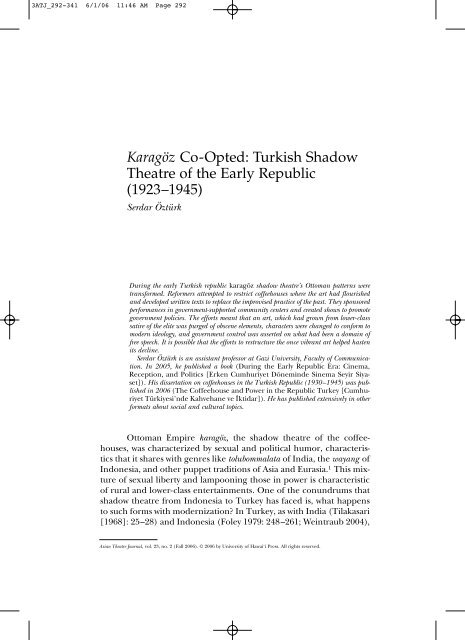
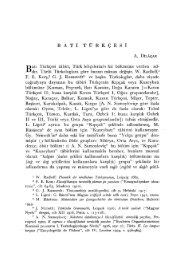
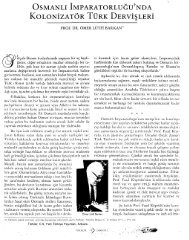

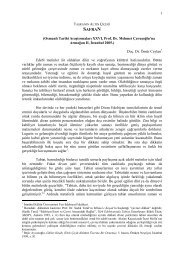

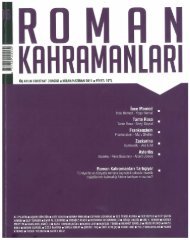
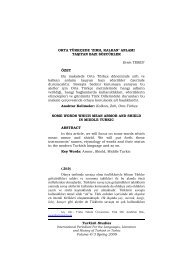

![Hll.IlbHble 6/11oiJa xaKaC06 [= Khakas national dishes] (Abakan 199](https://img.yumpu.com/21668274/1/190x138/hllilbhble-6-11oija-xakac06-khakas-national-dishes-abakan-199.jpg?quality=85)
